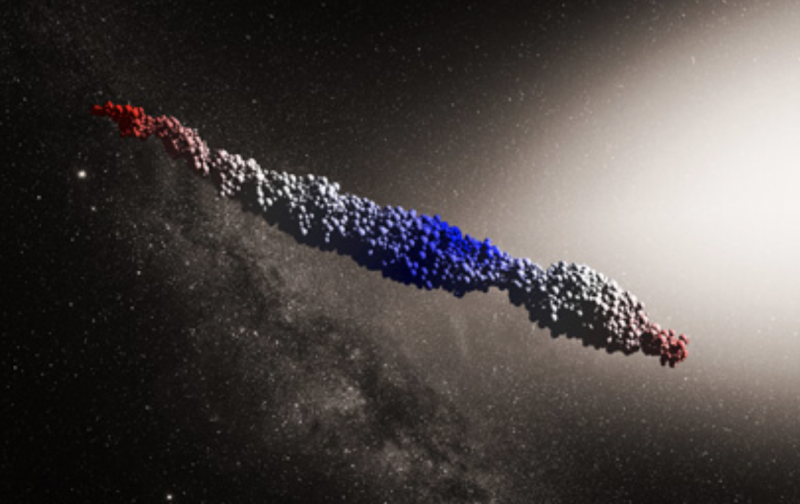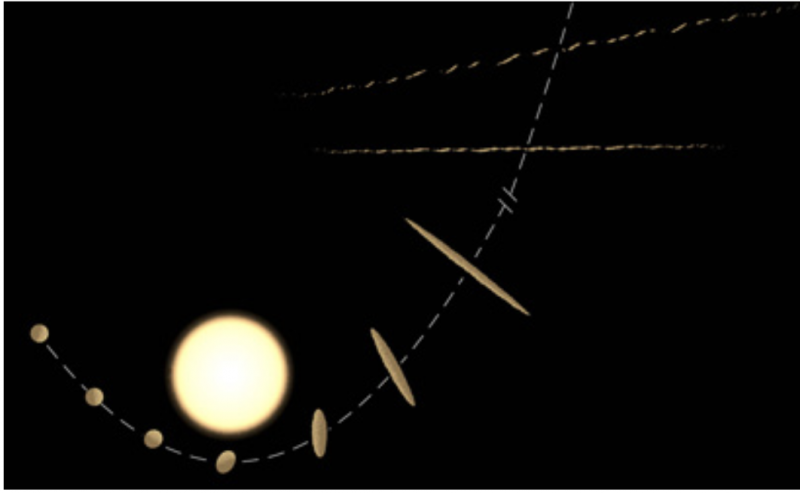
An astronomer using a telescope in Hawaii spotted the first known interstellar object in 2017. That was after astronomers had estimated that several such objects – natural objects not born in our solar system or bound to our sun – should pass inside Earth’s orbit each year. The IAU designated it as 1I/’Oumuamua, the 1I for first interstellar and ‘Oumuamua, which is Hawaiian for a messenger from afar arriving first. Astronomers on all parts of Earth had only a few months to study this object; when first spotted, it had already passed closest to our sun and was heading out of our solar system again. They found the object to be dry (not icy like a comet) and peculiarly elongated. How was it formed, and where did it come from? Now computer simulations appear to confirm what many had suggested: that ‘Oumuamua came to us after a close encounter with its parent star and that it might, indeed, be a fragment of a shattered alien world.
The study was published April 13, 2020, in the peer-reviewed journal Nature Astronomy
First author is Yun Zhang at the National Astronomical Observatories of the Chinese Academy of Sciences. Zhang and Douglas N. C. Lin at UC Santa Cruz used computer simulations to show how objects like ‘Oumuamua can form under the influence of tidal forces like those felt by Earth’s oceans. Lin said in a statement:
We showed that ‘Oumuamua-like interstellar objects can be produced through extensive tidal fragmentation during close encounters of their parent bodies with their host stars, and then ejected into interstellar space.

‘Oumuamua passed closest to our sun in September 2017, a month before astronomers spotted it with the Pan-STARRS1 telescope in Hawaii. Because of its unusually elongated shape and its path into and out of our solar system, astronomers even wondered if it might be an alien probe (shades of Arthur C. Clarke’s classic novel “Rendezvous with Rama“). Zhang commented:
It is really a mysterious object, but some signs, like its colors and the absence of radio emission, point to ‘Oumuamua being a natural object.
Still, it wasn’t like any natural object seen before. Astronomers might have expected the first known interstellar object to be an icy body like a comet. Indeed, the second known interstellar object – 2I/Borisov, first spotted in August 2019 – appeared to be a comet. That made sense because a reservoir of comets is thought to exist in the outermost part of our solar system. And – if our solar system formed in such a way as to create this Oort Cloud of comets – perhaps other solar systems did, too. The comets in these clouds might be expected to be tossed out of their host systems on occasion. No one knows how far Oort Clouds might extend. It’s not inconceivable that the Oort Clouds of nearby stars might even mingle a bit.
But comets are noticeably icy. They’re rich in what are called volatiles – elements that pass quickly from a solid to a gaseous state – which give comets their characteristic tails when warmed by the sun. 2I/Borisov’s appearance did change, for example, during its passage closest to our star.
But 1I/’Oumuamua looks very different. Its surface, for example, appears dry, not rich in volatiles, indicating it’s likely more rocky than icy. Zhang explained that astronomers have calculated that there must be a large population of interstellar objects like ‘Oumuamua, saying:
The discovery of ‘Oumuamua implies that the population of rocky interstellar objects is much larger than we previously thought. On average, each planetary system should eject in total about a hundred trillion objects like ‘Oumuamua. We need to construct a very common scenario to produce this kind of object.

Zhang and Lin ran high-resolution computer simulations in an attempt to re-create the scenario in which objects like ‘Oumuamua might form. They focused on tidal forces, thought to be a common process; we know, for example, that the pull of gravity causes ocean tides. And we know the pull of larger objects’ gravity can cause smaller objects to break apart, due to tidal forces; Saturn’s rings might have formed from moons that broke apart, for example. Their statement explained:
When a smaller body passes very close to a much bigger one, tidal forces of the larger body can tear the smaller one apart, as happened to comet Shoemaker-Levy 9 when it came close to Jupiter.
They pointed out that this tidal disrupt might also eject an object out of its solar system:
The tidal disruption processes can eject some debris into interstellar space, which has been suggested as a possible origin for ‘Oumuamua.
They took ‘Oumuamua’s shape into account, and the strengths of various materials that might compose it, saying:
The elongated shape is more compelling when we considered the variation of material strength during the stellar encounter. The ratio of long axis to short axis can be even larger than ten to one
And they used computer modeling to show the heat involved in such a disruption, showing that:
… the surface of fragments resulting from the disruption of the initial body would melt at a very short distance from the star and recondense at greater distances, thereby forming a cohesive crust that would ensure the structural stability of the elongated shape.
They have high confidence in their model, which explains many observed characteristics of ‘Oumuamua. They said their model offers “a first comprehensive answer” to many of the questions about ‘Oumuamua. Zhang also pointed out:
The tidal fragmentation scenario not only provides a way to form one single ‘Oumuamua, but also accounts for the vast population of asteroid-like interstellar objects.
And their statement said:
The researchers’ calculations demonstrate the efficiency of tidal forces in producing this kind of object. Possible progenitors, including long-period comets, debris disks, and even super-Earths, could be transformed into ‘Oumuamua-size pieces during stellar encounters.
This work supports estimates of a large population of ‘Oumuamua-like interstellar objects. Since these objects may pass through the domains of habitable zones, the possibility that they could transport matter capable of generating life (called panspermia) cannot be ruled out.
According to Lin,
‘Oumuamua is just the tip of the iceberg. We anticipate many more interstellar visitors with similar traits will be discovered …
Bottom line: Scientists using computer simulations determined that ‘Oumuamua, the first interstellar object spotted passing through our solar system, could have formed via a close encounter with its star as debris or even as a fragment of a shattered super-Earth.
Source: Tidal fragmentation as the origin of 1I/2017 U1 (‘Oumuamua)











